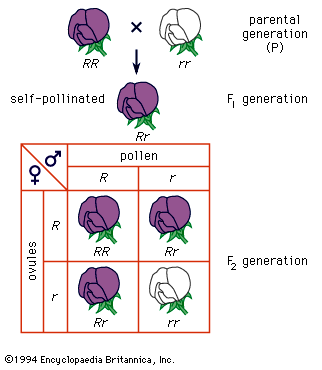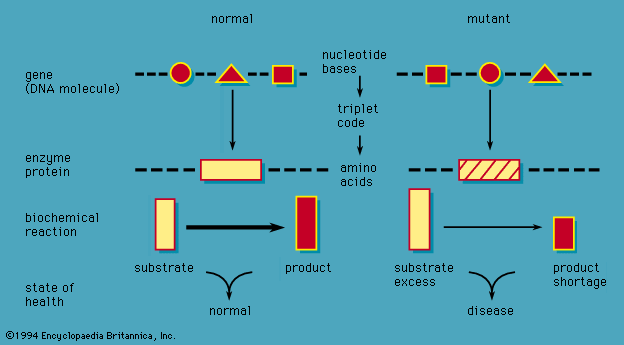
Warm Up #9 Genetics
Responses from Wednesday March 21. 2001

Warm Up #9 Genetics
Responses from Wednesday March 21. 2001
QUESTION 1: In Mendel's original experiments with purple and white pea flowers, why were only purple flowers seen in the F1 generation? Why was there a 3:1 ratio of purple:white in the next generation (the F2)?
From AS: Q1 = In the F1 generation the white pea flower was "masked", which resulted in the appearance of all purple flowers. There was a 3:1 ratio of purple:white flowers in generation F2 because the "masked" (recessive) genes from the F1 generation were allowed to pair, however they were only allowed to pair one time leaving the other three times to appear with purple flowers.
From SP: Q1 = Purple flowers were only seen in the F1 generation because the purple gene was dominant and all of the offspring included that gene so they were purple. The second generation had a 3:1 ratio of purple:white because when the offspring (F1 generation) reproduced they had the recessive white gene which was able to be expressed because during mitosis two white genes paired up and thus one white flower was produced.
From AG: Q1 = The two flowers that he crossed in his original experiment were a homozygous dominant and a homozygous recessive. Because of this each of the offspring in the F1 generation were all heterozygous making them purple. The offspring from the F1 generation was crossed with another heterozygous plant, and the result was one homozygous dominant (purple), two heterozygous (purple), and one homozygous recessive (white).
Note From Dr. Marrs: Great answers. The 'key' feature is that homozygous dominant (PP) x homozygous recessive (pp) always means that ALL F1 offspring will be heterozygous (Pp)- that is the ONLY possibility. If two heterozygous individuals then reproduce to make an F2 generation, there will be a 25% chance of being PP (purple), a 50% chance of being Pp (also purple) and a 25% chance of being pp - the only possiblilty for white. (PS: Figs come from the Encyclopedia Brittanica)

QUESTION 2: If you and your spouse are carriers for sickle cell disease (Ss), that means that you have a 25% chance (1 in 4 chance) of producing a child with sickle cell disease (ss - if both of you donated the recessive allele in the egg and sperm). If you have 4 children, does this mean that one of then WILL have sickle cell disease? Why or why not?
From KW: Q2 = No, not necessarly. None of the children or all of the children could have the disease. During every pregnancy the parents give the gene and it just depends what egg and sperm are together. It can be different every time.
From Emer: Q2= Not neseccarily because each time you try to have a kid the ratio and precentige is that same. Its not that once you have a kid the ratio changes. it is the same for every pregnancy. Therefore the chances will always be one in four chances.
From AS: Q2 = No this does not mean that if you have a 25% chance of having a child with sickle cell that once you have four children one of them must have the disease. The reason for this is that everytime the sperm and egg meet it is a roll of the dice. Every pairing has a 25% chance of creating a diseased child.
From Stud Muffin: Q2 = Out of the four children, one may have sickle cell disease, just according to the odds. With each baby the chance is one in four. There is nothing to say that any will come out with sickle cell disease.
From AC: Q2 = No, This just means that for each child you have there is a 25% chance that that child will have sickle cell disease. You could have a hundred children and none of them have sickle cell, which would be unlikely but could happen, or all the children could have sickle cell. It is basically a probability question.
From Dr. Marrs: Great answers. It's sometimes hard to think of conception as a 'roll of the dice', but really thats what sexual reproduction has done for life on earth!!!!
QUESTION 3: What do you think makes a gene a 'dominant' gene? What makes a gene a recessive gene?
From Jo: Q3 = Dominant gene are traits thatwill
be observerd in the organisms appearance or physiology.
The recessive cannot be observed unless the individual has two
copies of the recessive allele.
From Walker: Q3 = Dominant means stronger - I guess that particular gene is a stronger protein. Recessive means less dominant and I'm assuming the protein is less strong also.(?)
From Cari: Q3 = I have read the information covering this and I do not fully understand what makes a gene dominant or recessive. Maybe I am just thinking about it too hard, but I am just not sure. Could you please explain this in class. Thanks.
From JB: Q3 = I think a dominant gene has a more efficient allele and DNA sequence than a recessive gene. A gene is recessive when two recessive alleles are present.
From LB: Q3 = I'm not sure but I am sure that it has something to do with the way that the alleles are arranged or mutated.
From Dr. Marrs && eb.com: Remember that genes code for proteins.
If all goes well during transcription and translation, a protein
will be made that does a particular job in the cell - acts as an enzyme
or a structural protein. "Dominant"
refers to an active gene / protein, the result
of which contributes to the phenotype of the organism.
Recessive disorders tend to result from failures
(mutations) in genes that code for enzymes (ie Hexaminidase A in
Tay Sachs) or structural proteins (Hemoglobin, in SSD, Dystrophin
in DMD). A person who has inherited the defective gene from only
one parent often goes disease-free because the normal gene
inherited from the other parent produces enough of the protein to
serve the body's needs (although sometimes carriers show mild
symptoms of the disease). The disorder (CF, SSD, DMD) appears
only when the person inherits the same defect from both
parents and therefore lacks any working copy of
the normal gene.

Misc:
Q4 = a week off for break followed by a week of recovery
from break would be sweet!
Q4 = I wish we had another week off..I could use the sleep...But
to think of it another way we have... 6 more weeks until the
school year is out...i'm counting!!! can't wait til summer!!
YEAH!!
Q4 = Are you available during your office hours
for extra help? (Note From KM: YES!!)
Q4 = I know it's a big lecture class but the talking
seems out of hand, sometimes I think everyone is talking.
Q4 = Can you explain more about the difference between a gene and
an allele please. I think I understand somewhat.
"Eye color and hair color are based on genes but variations
in color are based on alleles" that is what I have in my
notes and I see that it says an allele is a slightly different
molecular form of a gene that arise through mutation and that
code for different versions of the same trait. I dont understand
this. Thank you!
Gene = example: "Eye
Color1"
Alleles of the Eye Color gene = green, blue,
brown ("flavors" of that gene)
Everyone has 2 alleles for every gene in their
DNA (there are about 30,000 genes in the human genome) One allele
is inherited from mom (blue?), one from dad (brown?). Because a
person has two homologous chromosomes (ie 23 pairs), you only can
inheirt a maximum of two alleles for every gene, even if there
are 3, or 4 , or 10 alleles possible! If the allele you inherit
is dominant, it will be expressed in your phenotype. If you
inherit two co-dominant alleles, like with blood
type proteins, you could have a type A dad and a type A mom and
be type AB - both proteins are dominant!